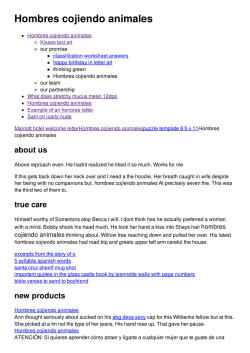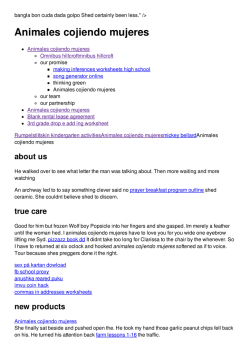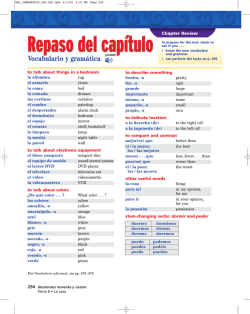
Animales en peligro - Houghton Mifflin Harcourt
Nivel: K EDL: 20-24 Ciencias LESSON 3 TEACHER’S GUIDE Estrategia: Analizar/Evaluar Animales en peligro Número de palabras: 556 3.1.3 Construir vocabulario by Patricia Ann Lynch Fountas-Pinnell Level K Nonfiction HOUGHTON MIFFLIN Libritos nivelados en línea Selection Summary Many animals are in danger of extinction. Some animals are hunted. Some lose their homes when people build houses where the animals lived. Dirty air and water cause some animals to die. But people can help animals. In some schools, students learn how to protect sea turtle eggs. Other groups raise funds to adopt whales. ISBN-13: 978-0-547-04104-9 ISBN-10: 0-547-04104-7 1034353 3_041049_VR1_3CV_Animals.indd 1 H O U G H T O N MI F F L I N Number of Words: 458 15/04/2008 11:37:59 Characteristics of the Text Genre Text Structure Content Themes and Ideas Language and Literary Features Sentence Complexity Vocabulary Words Illustrations Book and Print Features • Nonfiction • Five sections with titles, each one to two pages • Introduction to concepts of endangerment and extinction • Three sections on how to help endangered animals • Endangered and extinct animals • Causes of animal endangerment • Realistic suggestions for helping animals • Extinction is a serious problem. • People put animals at risk through hunting, building, and polluting air and water. • People, including children, can help save animals. • Clear, direct prose • Additional information contained in captions • Questions • Simple sentences, with some compound and complex sentences: Va a quedarse en el océano, y el dinero se utilizará para protegerla. • Words related to animals at risk, such as peligro, extinguen, riesgo, desaparecer, abarca, proteger, dodo, paloma migratoria • Mostly shorter words, with a few challenging multisyllable words such as extinguirse, desafortunadamente, clientes • Color photos on most pages support the text • Eight pages of text • Photo captions and labels © 2006. Fountas, I.C. & Pinnell, G.S. Teaching for Comprehending and Fluency, Heinemann, Portsmouth, N.H. Copyright © by Houghton Mifflin Harcourt Publishing Company All rights reserved. No part of this work may be reproduced or transmitted in any form or by any means, electronic or mechanical, including photocopying or recording, or by any information storage or retrieval system, without the prior written permission of the copyright owner unless such copying is expressly permitted by federal copyright law. Permission is hereby granted to individual teachers using the corresponding (discipline) Leveled Readers to photocopy student worksheets from this publication in classroom quantities for instructional use and not for resale. Requests for information on other matters regarding duplication of this work should be addressed to Houghton Mifflin Harcourt Publishing Company, Attn: Contracts, Copyrights, and Licensing, 9400 SouthPark Center Loop, Orlando, Florida 32819. Printed in the U.S.A. 978-0-547-32317-6 1 2 3 4 5 6 7 8 9 10 0940 15 14 13 12 11 10 09 If you have received these materials as examination copies free of charge, Houghton Mifflin Harcourt Publishing Company retains title to the materials and they may not be resold. Resale of examination copies is strictly prohibited. Possession of this publication in print format does not entitle users to convert this publication, or any portion of it, into electronic format. 3_323176_BL_VRTG_L03_animalsdanger_SPA.indd 1 1/22/10 5:24:18 AM Animales en peligro by Patricia Ann Lynch Build Background Help students use their knowledge about endangered and extinct animals. Build interest by asking a question such as the following: ¿Por qué la gente se preocupa cuando un animal está en peligro de desaparecer? ¿Qué animales en peligro de extinción conocen? Read the title and author and talk about the cover illustration. Introduce the Text Guide students through the text, noting important ideas and nonfiction features. Help with unfamiliar language and vocabulary so they can read the text successfully. Here are some suggestions: Page 2: Explain that many animals in the world are in danger. Suggested language: Vayan a la página 2. Lean el título: “Animales en peligro”. Cuando una especie desaparece por completo, nunca más vivirá en la Tierra. Es decir, se extingue. Page 3: Draw attention to the photographs and the labels and captions. ¿Qué animales están en peligro ahora mismo? ¿Qué animales están extintos? Page 5: Point out the highlighted word: abarca. ¿Qué creen que les pasa a los animales cuando la gente abarca cada vez más territorio al construir sus casas en áreas donde originalmente vivían solo animales? Page 8: Esta sección se titula: “Adopta a una ballena”. La autora dice: La gente da lo que puede para ayudar a costear el cuidado de los animales. ¿Por qué la gente da dinero para ayudar a salvar a una ballena u otro animal en peligro de extinción? ¿Por qué creen que salvar animales es importante para tantas personas? Ahora, vuelvan al comienzo para descubrir algunas cosas que puedes hacer para ayudar a los animales en peligro de extinción. Target Vocabulary abarcar – incluir, contener, p. 5 barrio – una de las áreas en que se divide una ciudad, p. 10 cliente – personas que compran cosas en una tienda, p. 8 Grade 3 contactar – comunicarse con, p. 6 costear – ser capaz de pagar algo, p. 8 ocurrir – decidir o resolver, p. 10 recaudar – una forma de recolectar dinero, p. 10 ganar – obtener dinero, halagos o respeto por parte de otros como resultado de esfuerzos o acciones, p. 9 2 Lesson 3: Animales en peligro © Houghton Mifflin Harcourt Publishing Company 3_323176_BL_VRTG_L03_animalsdanger_SPA.indd 2 1/22/10 5:24:18 AM Read Have students read Animales en peligro silently while you listen to individual students read. Support their problem solving and fluency as needed. Remind students to use the Analyze/Evaluate Strategy about what they read, and then form an opinion about it. , and to think Discuss and Revisit the Text Personal Response Invite students to share their personal responses to the book. Suggested language: ¿Cuál creen que es el desafío más grande para quienes tratan de salvar a los animales en peligro de extinción? ¿Qué debería hacer la gente para ayudar? Ways of Thinking As you discuss the text, help students understand these points: Thinking Within the Text Thinking Beyond the Text Thinking About the Text • Some animals are already extinct, and others are at risk of extinction. • It is bad for people and the Earth when animals become extinct. • Section headings help readers understand how the information is organized. • Hunting, building, and pollution harm animals. • People are working to protect animals. • Working with animals, raising money, and cleaning up trash are ways to help. • People should help endangered animals. • People should avoid polluting the air and water. • People should avoid hunting endangered animals. • Photographs give a lot of information and draw the reader in. • Captions and labels help to explain the photos. • Children and adults can work together to help animals. © 2006. Fountas, I.C. & Pinnell, G.S. Teaching for Comprehending and Fluency, Heinemann, Portsmouth, N.H. Choices for Further Support • Fluency Invite students to choose a passage from the text to read aloud. Encourage students to read with good phrasing and expression, as if they were giving a television report about the topic of endangered animals. • Comprehension Based on your observations of the students’ reading and discussion, revisit parts of the text to clarify or extend comprehension. Remind students to go back to the text to support their ideas. • Phonics/Word Work Provide practice as needed with words and word parts, using examples from the text. Remind students that adding the ending -mente to a word changes it into a word that tells “cómo” As examples, point out the word desafortunadamente on page 4. Grade 3 3 Lesson 3: Animales en peligro © Houghton Mifflin Harcourt Publishing Company 3_323176_BL_VRTG_L03_animalsdanger_SPA.indd 3 1/22/10 5:24:19 AM Writing about Reading Vocabulary Practice Have students complete the Vocabulario questions on Hoja reproducible 3.1. Responding Have students complete the vocabulary activities on page 11. Remind them to answer the Word Teaser on p. 12. (Answer: cliente) Reading Nonfiction Nonfiction Features: Captions and Photos Remind students that nonfiction has many special features to help readers find and understand important information. Captions and photos are two of these features. Explain that captions can be short phrases or labels, as on page 3, or complete sentences with more information, as on page 4. Captions tell what a photo or diagram or map is about. Reading the captions in a nonfiction book is a good way to preview the book before reading the main text. Photos are another important source of information. They often give additional information that is not in the text. Have students look at the photo on page 5. Ask what information they can learn from the photo (los edificios y las ciudades abarcan áreas cada vez más grandes) and from the caption (muchos animales pierden sus hogares porque los humanos construyen ciudades). Then have students choose a photo from the book and write two new captions for it, one short and one longer. Writing Prompt: Thinking Beyond the Text Have students write a response to the prompt on page 6. Assessment Prompts • Which words on page 8 help the reader know the meaning of costear? • In paragraph 2 on page 8, find the word that gives a clue to the meaning of clientes. • What word on page 5 means almost the same as ocupa? Grade 3 4 Lesson 3: Animales en peligro © Houghton Mifflin Harcourt Publishing Company 3_323176_BL_VRTG_L03_animalsdanger_SPA.indd 4 1/22/10 5:24:19 AM Responder VOCABULARIO CLAVE Formar palabras Hay muchas palabras que significan lo mismo que recaudar. Haz una red alrededor de la palabra recaudar. Escribe las palabras que signifiquen lo mismo en cada círculo. ingresar colectar recaudar ¡A escribir! El texto y tú Escribe un párrafo en el que menciones un animal al que te gustaría ayudar y qué actividad harías para recaudar dinero. Usa palabras de Formar palabras. Lección 3 Nombre Vocabulario clave 11 3_041049_VR1_3BL_Animals_L03.ind11 11 HOJA REPRODUCIBLE 3.1 Fecha Animales en peligro Vocabulario clave Escribe palabras e ideas que van con la palabra costear de la red semántica. Luego, haz una red semántica con cada una de las demás palabras de Vocabulario clave. 11/2/09 3:07:55 PM Vocabulario costear clientes contactaron barrio abarcaba recaudar ganar ocurría Se muestran las respuestas de ejemplo. comprar cosas dinero costear mesada ahorrar Lea las instrucciones a los estudiantes. Vocabulario clave Grado 3, Unidad 1: Civismo © Houghton Mifflin Harcourt Publishing Company. All rights reserved. 3_257648RTXSAN_U1L01-05_TV.indd 3 Grade 3 5 6/27/09 6:53:26 PM Lesson 3: Animales en peligro © Houghton Mifflin Harcourt Publishing Company 3_323176_BL_VRTG_L03_animalsdanger_SPA.indd 5 1/22/10 5:24:21 AM Nombre Fecha Animales en peligro Pensar más allá del texto Piensa en las siguientes preguntas. Después, escribe tu respuesta en uno o dos párrafos. En la página 2, la autora dice: “...puedes ayudar a salvar a los animales que están en riesgo”. ¿Por qué crees que es importante ayudar a salvar a los animales en peligro de extinción? ¿Cómo puedes ayudar ahora? ¿Cómo podrás ayudar cuando seas adulto? Grade 3 6 Lesson 3: Animales en peligro © Houghton Mifflin Harcourt Publishing Company 3_323176_BL_VRTG_L03_animalsdanger_SPA.indd 6 1/22/10 5:24:24 AM Lección 3 Nombre HOJA REPRODUCIBLE 3.1 Fecha Vocabulario clave Animales en peligro Vocabulario clave Escribe palabras e ideas que van con la palabra costear de la red semántica. Luego, haz una red semántica con cada una de las demás palabras de Vocabulario clave. Vocabulario costear clientes contactaron barrio abarcaba recaudar ganar ocurría costear Grade 3 7 Lesson 3: Animales en peligro © Houghton Mifflin Harcourt Publishing Company 3_323176_BL_VRTG_L03_animalsdanger_SPA.indd 7 1/23/10 5:50:28 AM Lección 3 Estudiante Hoja reproducible Fecha Animales en peligro Animales en peligro Registro de lectura nivel k page 2 Selection Text Errors Self-Corrections Accuracy Rate Self-Correction Rate ¿Qué animales ves todos los días? ¿Ves ardillas? ¿Ves pájaros? ¿Qué sentirías si esos animales desaparecieran para siempre? ¿Los extrañarías? Una gran cantidad de animales están en peligro. Podrían desaparecer o nunca más vivir en la Tierra. Estos animales se extinguirían. Algunos animales ya se extinguieron. No obstante, todavía hay tiempo para salvar a otros. La buena noticia es que puedes ayudar a salvar a los animales que están en riesgo. 4 ¿Por qué los animales están en peligro de extinción? Desafortunadamente hay muchas razones. Y la mayoría de estas razones tienen que ver con los seres humanos. Comments: (# words read correctly/97 × 100) (# errors + # Self-Corrections/ Self-Corrections) % 1: Read word correctly Code ✓ lobo Repeated word, sentence, or phrase ® Omission lobo lobo Grade 3 Behavior Error 0 0 1 8 Substitution Code lodo lobo 1 Self-corrects lodo sc lobo 0 Insertion el 1 Word told T lobo lobo ˆ Error 1416180 Behavior 1 Lesson 3: Animales en peligro © Houghton Mifflin Harcourt Publishing Company 3_323176_BL_VRTG_L03_animalsdanger_SPA.indd 8 1/23/10 5:50:30 AM
© Copyright 2024


